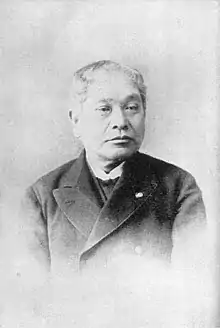Ōki Takatō
Ōki Takatō (大木 喬任, March 23, 1832 – September 26, 1899), was a Japanese statesman during the early Meiji period. He was Governor of Tokyo in 1868 and a member of the Japanese Privy Council in 1889.[1]
Ōki Takatō 大木 喬任 | |
|---|---|
 | |
| President of the Privy Council of Japan | |
| In office 30 October 1889 – 1 June 1891 | |
| Monarch | Meiji |
| Preceded by | Ito Hirobumi |
| Succeeded by | Ito Hirobumi |
| In office 8 August 1892 – 11 March 1893 | |
| Preceded by | Ito Hirobumi |
| Succeeded by | Yamagata Aritomo |
| Personal details | |
| Born | March 23, 1832 Saga, Japan |
| Died | September 26, 1899 (aged 67) |
| Occupation | Cabinet Minister |
Biography
Ōki was born into a samurai family in Saga, in Hizen province (present-day Saga prefecture). He studied at the domain school Kodokan, and promoted reform of the domain administration. During the Boshin War he was a leader in the Saga forces committed to the overthrow of the Tokugawa shogunate.
After the Meiji Restoration, he supervised the transfer of the imperial capital from Kyoto to Tokyo, and was appointed the first Governor of Tokyo.
In 1871, he became Education Minister and is credited with establishing Japan's modern educational system. In 1873, he became sangi (councillor) and in 1876, Justice Minister and was concerned with the punishment of the disgruntled ex-samurai involved in the Hagi Rebellion and the Shimpūren Rebellion. In 1880, he became chairman of the Genrōin . He also worked on developing Japan's civil code as the president of the ‘Civil Code Compiling Council’.
In 1884, he was elevated to the title of hakushaku (count) in the new kazoku peerage system.
From 1888 he served on the Privy Council, becoming chairman in 1889. Later he was appointed Justice Minister under the first Yamagata administration, and the Education Minister under the first Matsukata administration.
His eldest son, Ōki Enkichi was also a politician, and a cabinet member during the Taishō period.
Notes
- Nussbaum, Louis-Frédéric. (2005). "Ōki Takatō" in Japan Encyclopedia, p. 747, p. 747, at Google Books.
References
- Akamatsu, Paul (1972). Meiji 1868 : Revolution and Counter-Revolution in Japan. Translated by Miriam Kochan. New York: Harper & Row.
- Beasley, William G. (1972). The Meiji Restoration. Stanford: Stanford University Press. ISBN 9780804708159.
- Jansen, Marius B. and Gilbert Rozman, ed. (1986). Japan in Transition: from Tokugawa to Meiji. Princeton: Princeton University Press. ISBN 9780691054599. OCLC 12311985
- Keene, Donald (2002). Emperor of Japan: Meiji and His World, 1852-1912. New York: Columbia University Press. ISBN 978-0-231-12340-2.OCLC 46731178
- Nussbaum, Louis-Frédéric and Käthe Roth (2005). Japan encyclopedia. Cambridge: Harvard University Press. ISBN 978-0-674-01753-5. OCLC 58053128
- Ravina, Mark (2004). The Last Samurai: The Life and Battles of Saigo Takamori. Hoboken, New Jersey: Wiley. ISBN 9780471089704.; OCLC 427566169

